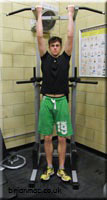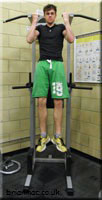

Chin Up Test
Testing and measurement are the means of collecting information upon which subsequent performance evaluations and decisions are made. In the analysis, we need to consider the factors influencing the results.
Objective
The objective of the Chin Up Test is to monitor the athlete's arm and shoulder muscular endurance development.
Required Resources
To conduct this test, you will require:
- Chinning bar.
- Assistant.
How to conduct the test
- The athlete warms up for 10 minutes.
- The athlete hangs from the bar with the palms of their hands facing them and arms straight (start position).
- The athlete, using the arms, pulls the body up until the chin is above the bar and then lowers the body to the start position.
- The athlete continues with the pull-ups until they are unable to continue or let go of the bar.
- The assistant counts and records the number of completed pull-ups.
 |
 |
Analysis
Analysis of the test result is done by comparing it with the athlete's previous results for this test. With appropriate training between each test, the analysis expected that the analysis would indicate an improvement in the athlete's arm and shoulder strength endurance.
Target Group
This test is suitable for active individuals but not for those where the test would be contraindicated.
Reliability
Test reliability refers to how a test is consistent and stable in measuring what it is intended to measure. Reliability will depend upon how strictly the test is conducted and the individual's level of motivation to perform the test. The following link provides various factors influencing the results and test reliability.
Validity
Test validity refers to the degree to which the test measures what it claims to measure and the extent to which inferences, conclusions, and decisions based on test scores are appropriate and meaningful. This test provides a means to monitor the effect of training on the athlete's physical development.
Advantages
- Minimal equipment required.
- Simple to set up and conduct.
Disadvantages
- Specialist equipment required.
- Assistant required to administer the test.
References
- DAVIS, B. et al. (2000) Physical Education and the study of sport. 4th ed. London: Harcourt Publishers. p. 124
Page Reference
If you quote information from this page in your work, then the reference for this page is:
- MACKENZIE, B. (2004) Chin Up Test [WWW] Available from: https://www.brianmac.co.uk/chinstst.htm [Accessed